That’s right; I used a Something about Mary reference fourteen years later in the title because lately I’ve been digging on the lighter side of brewing. And no, I’m not talking about Bud Light clones. Although, don’t hate me, that is my go to crappy light beer choice when push comes to shove. No, I’m talking about a nice session beer. But in a homebrewing/craft beer world dominated by insanely hopped India Pale Ales, deadly dark Russian Imperial Stouts and other random genre blending, imperializing, oaked, soured, wet hopped, Belgianized brews where does the simple session beer fit in? Well, let me tell you.
First off, they fit in whenever you don’t want to get annihilated off drinking three beers. Don't get me wrong, I love a nice big beer as much as the next guy, but as much as the craft beer world seems to work to separate themselves from mainstream American culture they seem to fit right in. Before you explode in anger stroke let me explain. They are the SUVs of beer. They are the Super Sized meal. They are the summer blockbuster. By this of course I mean bigger is better in the craft beer world. Now, of course this is not the golden rule but it’s hard to argue that 6% is not the new 5% and that anything above 7% is not somewhat common. So when you’re in the mood to throw a few back but still need to drive home and work tomorrow the session beer is for you.
(Interesting side note: it seems light (Lite?) beer is the only mainstream thing in America in which bigger is not better. And yes, I realize that my craft brew analogies are not perfect because craft beer is often of higher quality as opposed to the Big Mac or Transformers III: Crap on the Moon but still, they do tend to go big so I think my points stand)
But wait, you may find yourself saying “I like flavor” “I like hops” “I like body”. Well my friend, this brings me to point number two which is the fact that session beers can have all of these. If done right they’re easy on the liver yet tasty on the way down. Low alcohol, low
cost, low calorie (because remember, this is apparently important to the American beer drinker after eating three Big Macs), but still high in flavor. Toss back a great session beer for a truly nice beer that you can enjoy two of.
And finally, point number three, if you like big beer brewing and pounding back good old double digit ABV% beers then session beer brewing can be for you too. But wait, isn’t that kind of the opposite of this whole idea? Well yeah, it can be, but not if you’re talking about the resurrection of the partygyle brew! I’m not going to beat around the bush, I’ve only done this twice and the results were less than perfect (although not bad) but I love the idea. Mash in your monster, drain off the first runnings for the beast and then sparge your way to a nice little guy to enjoy every day. Gives you a longer (and hopefully more rewarding) brewed plus more beer for your
money.
So in short, I love low gravity beers. I’ve been playing around with a few test batches I need to write about, analyze and test out (mostly Milds, Bitters and the low gravity sessionized yet hop forward American Pale Ale) because like most craft beer drinkers and brewers I got caught up in the big beer craze so this is a bit of a foreign concept to me. But I like it! Simplicity plus technique plus knowledge of what ingredients you’re working with equals a good session beer. Or so I think, I guess I’ll need to test that out. My plan is to do some more research on this and do some writing on techniques but until then I think I’ll have twelve of these 3.5% beers and wake up sober.
(Interesting side note number two: I desperately need to do a write up on my one gallon basemalt SMaSH experiments because these are what got me into the whole session beer idea. No they are not fantastically interesting beers, but I love tossing them back on Sunday during the football game without nearly killing myself. So, hopefully in the near future I’ll pop open one each of the Maris Otter, Rahr 2-Row, Munich and Vienna EKG SMaSH brews, take some pictures and write up my findings.)
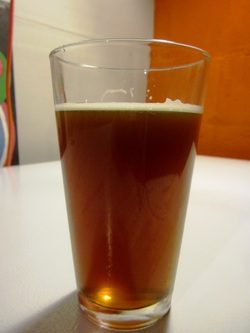 Aroma: No esters, no hops, no caramel. Just straight up Munich and Vienna malt aroma. Appearance: A deep, orangish red hue with a slightly off white head. Head retention could be better but nice clarity and color. Flavor: A bit of a malt bomb upfront with the combo of triple decocted Pilsner, Munich and Vienna but finishes fairly dry. There are some hints of alcoholic warmth which are mostly hidden with heavy malt flavor and the spiciness from the hops. Mouthfeel: Medium bodied, well carbonated and smooth. Could have a little more body but due to decoction mashing the wort was extremely fermentable leaving little residue sugar behind. Overall impression: Good! I like it quite a bit but that may just be the work I put into the decoction mash talking. I don’t drink a ton of German beer so this is far from my specialty but this is going down pretty easily for a 6.5% brew. Definitely smooth and rich but with more spiciness than I would have thought from just the one flavor addition I did. Next time I will have to make sure to figure in the added efficiency for the decoction because I clearly overshot my target leading to the Imperial Festivus naming of the beer. I don’t know, I may bottle this one up just for fun and send off a couple for competition. One last thing. It should be mentioned that this beer was fermented warm using a giant Bohemian Lager yeast starter. As seen in the Brewing TV episode Lager Workarounds studies at Wyeast have shown that this strand can ferment well at 60-65*F while maintaining lager characteristics. While I have access to a fermentation chamber now, I did not when this was brewed so this was my test run of this yeast and I think it turned out pretty well. No obvious flaws so give it a try. Decoction Posting: http://inhousebrew.weebly.com/1/post/2012/08/thoughts-on-decoction-mashing.htmlRecipe: http://inhousebrew.weebly.com/imperialist-festivalist.html
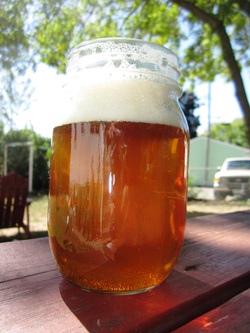 Like many American craft brew lovers I’m a big fan of hops. That said I’m not such a fan of only being able to drink a few of my favorite hoppy beers because of the alcohol content. Now of course I love a good IIPA but now that it is football season I like to sit back and have a handful of beers so I decided one of my brewing goals will be to create a low gravity, hoppy Pale Ale. Basically an American session beer. Working off of my previous Galaxy Pale Ale recipe I’ve tweaked a few things resulting in this: 5 lbs 4.0 oz Rahr 2-Row Pale (1.7 SRM) 58.3 % 2 lbs 12.0 oz Vienna Malt (3.5 SRM) 30.6 % 12.0 oz Caravienne Malt (22.0 SRM) 8.3 % 4.0 oz Biscuit Malt (23.0 SRM) 2.8 % 0.50 oz Cascade [5.50 %] - Boil 60.0 min 10.7 IBUs 0.50 oz Cascade [5.50 %] - Boil 15.0 min 5.3 IBUs 0.50 oz Galaxy [14.00 %] - Boil 10.0 min 9.9 IBUs 0.50 oz Cascade [5.50 %] - Boil 5.0 min 2.1 IBUs 0.50 oz Galaxy [14.00 %] - Boil 5.0 min 5.4 IBUs 1.0 pkg American Ale II (Wyeast Labs #1272) [124.21 ml] 1.00 oz Galaxy [14.00 %] - Dry Hop 7.0 Days 0.50 oz Cascade [5.50 %] - Dry Hop 7.0 Days Thanks to the help of a brewing forum I recently decided I should try to stir more aggressivly when batch sparging so after draining the first runnings and mixing in the 180* water I vigorously stirred for two minutes. Low and behold my pre-boil gravity was almost ten points higher than anticipated and when everything was all said and done I overshot my final gravity by eight points upping my overall brewhouse efficiency from 72% to about 80%. So much for an Americanized session beer though as this tipped me over 5% ABV. Yet another new trick I tried on this brewday was whirlpooling my wort before chilling. The first thing I needed to do was rig up a copper diptube in place of the bazooka screen I had been using to keep hops out of the plate chiller. Easy enough process once the right tools were found. Next step was testing out the whirlpool action so I stirred my wort with a large sanitized spoon and let it sit for 10-15 minutes. I’ll admit the chilling process was a bit nerve racking as I was just waiting for the plate chiller to clog but everything went smoothly and I ended up with a nice little pile of hops in the middle of the pot with very little wort left behind. So, all in all a nice brewday. I learned a few things which I don’t know why I hadn’t tried yet but better late than never right? Also, I ended up with potentially a pretty nice Pale Ale that I may or may not end up scaling back to hit somewhere between 4-4.5% ABV.
 This was the best picture I got although I was alble to suck a little more wort out of this guy before all was said and done.
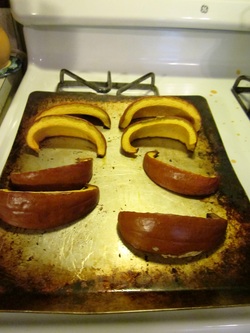 So I finally got around to brewing my Pumpkin Brown Ale recipe that I developed and detailed in Part One and Part Two about a month ago. There were a few last minute changes I made to my recipe and the process. Based on Northern Brewer’s video detailing how to add a pumpkin to your mash I changed up my methodology and instead of roasting the pumpkin in chunks and adding it to the mash as is I roasted it in quarters, pealed the skin off, smashed it up, added it to some hot water and then dumped it in the mash. Overall, a pretty easy process and the kitchen smelled wonderful. I’d say everything went really smoothly which could be due partly to the fact that I did a three gallon BIAB batch so I didn’t need to worry about sparging which I have repeatedly seen people online complaining about. So, having avoided that mess I pretty much nailed this one right on the head. I added two pounds of pumpkin for a 3 gallon batch which went off without a hitch and the pumpkin spices I added in the last five minutes smelled excellent the second I dropped them in. Guess we got a ways to go before any tasting notes come through but the hydrometer sample tasted just like I would want it too; pretty much a English style Brown Ale with a hint of pumpkin spice. This started off as a project for the girlfriend but now that it’s bubbling away I’m honestly pretty curious about this beer so I’m anticipating the day it is ready to be sampled cold and carbonated. Marris Otter (3 SRM) 76.9% C-80 (80SRM) 15.4% Amber Malt (22 SRM) 3.8% Briess Organic Chocolate Malt (350 SRM)3.8 Two Pounds of Pumpkin in the mash 60 minutes: 16.5 IBUsEast Kent Goldings 10 minutes: 6 IBUs East Kent Goldings 5minutes: 1/2ts cinnamon, 1/4ts ginger, 1/8 teaspoon nutmeg, 1/8 ts clove
British Ale Wyeast 1098
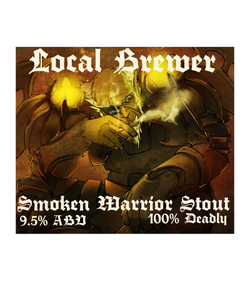 So, I started feeling bad about my big bottled beers after the death of the Kazakhstani Imperial Stout so on a whim tonight I decided to pop open a bottle of my nine month old Smokin’ Warrior Stout and man is it good! This whole batch was a bit of a test run in many regards. First off, it was one of the first stovetop BIAB batches I did so I really had no idea what was going on. Secondly, I had never used Briess Cherrywood Smoked Malt, their new Midnight Wheat or done an all grain Imperial stout so I decided to toss each into this small 1.5 gallon test run of big beer for fun. Because I was embarking on an experimental journey I decided on the Warrior hops I don’t believe I had used before which gave me the obvious benefit of an awesome, recipe appropriate name for the beer; the Smokin’ Warrior Stout. On top of that, when I Google image searched smoking warrior this picture came up and I stole it and made an awesome label.
Overall impressions, this beer is not for everyone. It’s a sipper at 9.5% ABV and in all honesty should have been more but it only attenuated to about 70% leaving the beer sweet, full bodied and awesome for an Imperial Stout. The smoked malt comes in at just the right level and while my girlfriend equated it to licking a burnt log I thought it was pretty damn tasty. All in all, after nine months I think the smoked malt, the residual sweetness and the hop bitterness have balanced out into something pretty good. Maybe worth a slightly larger batch next time. Next time I might swap in some MO in place of whatever I got for Pale Malt and would probably drop the brown sugar down a bit. Of course, I’m writing this after the glass so it’s all based on memory which is skewed from a 9.5% beer and a couple PBRs.
I re-added this beer to my Beersmith files (after I lost everything on my computer crash….) and adjusted it to five gallons just in case I start feeling frisky. Let me
know if anyone has brewed anything similar.
Ingredients
11 lbs 12.0 oz Pale Malt (2 Row) US (2.0 SRM)
Grain 1 56.0 %
4 lbs Briess Cherrywood Smoked Malt (4.0 SRM) Grain 2 19.0 %
1 lbs 12.0 oz Briess Midnight Wheat (550.0 SRM) Grain 3 8.3 %
12.0 oz Cara-Pils/Dextrine (2.0 SRM) Grain 4 3.6 %
12.0 oz Chocolate Malt (450.0 SRM) Grain 5 3.6 %
2 lbs Brown Sugar, Light (8.0 SRM) Sugar 6 9.5 %
2.00 oz Warrior [15.00 %] - Boil 60.0 min Hop 7 70.8 IBUs
American Ale II (Wyeast Labs #1272) [124.21 ml] Yeast
Est Original Gravity: 1.112 SG
Est Final Gravity: 1.021 SG
Estimated Alcohol by Vol: 12.3 %
Bitterness: 70.8 IBUs
Est Color: 65.3 SRM
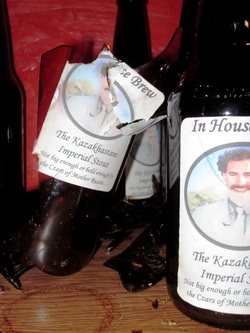 So first off let’s discuss the name because I loved it. This was supposed to be a test batch of a Russian Imperial Stout however somewhere along the line I messed up on a few fronts. It was supposed to be 1.089 but due to this being my first big beer on the stove top BIAB system I undershot and wound up at 1.074. Then there was the color. It was dark but not as black as I would have liked it to have been. So therefore, with the low ABV% and the lacking depth of darkness a friend of mine decided it was not a brew fit for the Czars of Russia so we named it the Kazakhstani Imperial Stout. Added bonus, this also allowed for me to put Borat on the label. After tasting it at a month in the bottles I’d say it was pretty well on its way to becoming a passable Stout.
But (because there’s always a but) it didn’t ferment out properly. My notes indicate it finished fermenting very quickly and only reached a 70% attenuation finishing at 1.025 after three weeks. I wish I could say how much priming sugar I added but my computer crashed and I lost all of my files to Beersmith and didn’t write it down on my paper copy of the recipe. So, we’ll just have to assume that I added too much based on the high final gravity.
 This is a topic I see pop up an awful lot on homebrew forums and since I like brewing big beers I thought I'd do some more research, take some notes and write up something that is concise and easy to understand to help myself and anyone else looking into this.
So why does this come up so often? I believe the reason is because new brewers often want to jump into big beer brewing without mastering the basics first so there are frequently questions about restarting stuck ferementations or off flavors or uncarbinated bottles. So nothing in this posting is going to be very technical, just the basics of what you need to in order to make a good big beer.
Rule #1. Do it right from the beginning.
Read these links and my tips so you don't end asking questions about restarting fermentation on a sickly sweet 1.043 Russian Imperial Stout. You don't want to end up there and it is avoidable. I've pulled most of my writing out of these links but going through them wouldn't hurt.
http://www.maltosefalcons.com/tech/thinking-big-getting-handle-brewing-big-beers
http://beerdujour.com/Howtobrewabigbeer.htm
http://beersmith.com/blog/2010/05/09/how-to-brew-big-making-high-gravity-beers/
Rule #2: Lots and lots and lots of yeast!
I'm starting here because this is the same for extract and all grain brewers. First off check your recipe and plan out your yeast starter (and yes, unless you want to spend a buttload of money on yeast packages you need a starter). I like Yeast Calculator for
determining how much to pitch. As far as I see it you have a few options here as to how to make a starter. Option number one; make a plain old yeast starter but unless you have a gigantic flask or a one gallon jug this might not be enough. So, option number two; make a stepped up starter. Again, I think yeast calculator has a nice design, is easy to use and has an option to calculate your own stepped up starters as well. Or you can avoid a bunch of that fuss and move on to option number three and make a starter beer. A regular low gravity, low IBU batch really is nothing more than a five gallon yeast starter. A full five gallons can be a bit too much yeast though and I personally like making half batches or even one gallon batches so just brew up one of those around 1.040-1.050 with little hop character, rack it at two weeks and pitch the yeast cake into you big beer wort. Boom, starter beer.
Rule #3: Pay Attention to Fermentation
Once again (reference rule number one) if you're doing something that that costs this much money and takes this much time and effort make sure to do it right. Big beers can kick out a lot of heat because there is a lot going on in there during fermentation so to quote Scar from the Lion King, "Be Prepared". Best case scenario you toss it in your temp controlled chest freezer. If you don't have one of these this should be your next big purchase. An alternative would be the simple yet effective swamp cooler approach. It can work and help prevent temperature fluctuation. At the very, very least do these beers in the winter when your ambient temp isn't going to be 75*. While some alcoholic warmth is acceptable you don't want this tasting like rubbing alcohol because you fermented at 78* in the middle of July.
Secondly, beers with this much fermentable material tend to take a while to finish up. To help the yeast stay in suspension and not fall out before their job is done I like to
swirl my carboy three times a day after visible fermentation stops. Obviously no splashing here! Just a nice smooth rocking. Brewer's hundreds of years ago literally used to turn wooden kegs on their side and roll them around (they called it walking their beers) but this seems impractical for a carboy so I'd go with the rocking to help finish fermentation.
Finnally , one note on aging. I'm just tacking this on here to make sure you know you shouldn't drink your Barleywine after four weeks in the primary. These are investment beers, give it time then give it some more time and even a little more before you even think about bottling.
Rule #4: Grainbill, mashing and hops.
I’m not going to say a whole lot on the grainbill because I believe that this is up to you.
What I will say is not to go crazy. Just because this is a Big Beer it doesn’t need to have eight different malts and five different hop varieties. As with most beers, simplicity is best. Keep the crystal and specialty malts low because you want something that is
fermentable. Use the highest quality ingredients you can find. If you’re worried about fermentability of let’s say your RIS simple sugars can be your friend to help lower the FG. Dextrose is a popular choice or you can add some character sugars such as molasses or honey either to the boil or directly to the fermentation vessle.
As far as mashing goes you want to mash low and long. Again, the goal here is
fermentability. I know it sounds counterintuitive to mash low for something you want to have a heavy malt backbone like an English Style Barleywine but hypothetically with a beer that features 20lbs of Maris Otter you’re going to be fine in that department. I’m not going to go into it here but this is also a good time to start thinking about pary-gyle brewing.
The main concern with hop bitterness for a big beer is balancing out that heavy malt flavor so you need to keep in mind your bitterness ratio. This chart has the values
for what appears to be almost every style of beer. To find your bitterness ratio you take your estimated IBUs and divide by your estimated starting gravity and then check it with the chart. Adjust as needed until you are somewhere close. Yes, for a stout 75 IBUs may seem high but when paired with a high
gravity it is not.
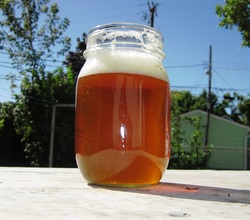 The Galaxy Pale Ale
84% Rahr 2-Row Pale
8.5% Biscuit Malt
8.5% C-20
60m- 26 IBUs Palisade
10m- 18 IBUs Galaxy
5m- 5 IBUs Palisade
Flameout- Galaxy
So this beer started off as a way to unload a bit of Biscuit Malt and some C-20 that I had laying around and while I was at the local brew shop I decided to pick up and try some Galaxy hots that I had been eying up for a while. Overall, a bit overly hopped and perhaps too much Biscuit for my taste but all in all not a terrible beer.
Aroma: Floral, fruity citrus coming off the first wafting of this beer. Nothing overpowering but it's definitely there from the late Galaxy and Palisade hop additions. Anything else from the malt is hidden behind.
Appearance: Rich golden color with a long lasting, slightly off white head. Moderate clarity but this beer is still relatively young and I didn't use the usual isinglass clearing routine on this one so I'm pretty satisfied with the way it looks.
Flavor: Heavy hop presence right off the bat and through the finish. This is probably due to the fact that I messed up one of the hop additions and added it sooner than I had planned upping the IBUs to almost 50 with a bitterness ratio of .94 making it more mouth puckering than I would have liked it to be for a low gravity APA. The nearly 10% Biscuit Malt lends a bready, saltine cracker flavor lining deep underneath all of the aggressive hoppy goodness while the C-20 adds almost nothing noticeable to the beer at all. Hop taste and bitterness lingers longer than I would like it too.
Mouthfeel: Overly carbonated and I'm wondering if the fact that I force carbed only three gallons of it in a five gallon keg at 35 PSI has something to do with this. Overall though I'd say it's a light bodied, easy drinker provided you love your hop bitterness.
Overall Impressions: A lack of attention on the timing of the hop additions has really bumped this beer into the overly-hopped category. Without much backing it up in terms of flavor from the yeast or any caramelly or malty flavors it really dominates while I think if brewed the way I had planned this might have been a pretty decent beer. Given a little time in the keg to mellow out it may turn out better but as of right now it's a bit much to handle. That said the Galaxy hops, which are really the reason I brewed this beer, provide a very interesting flavor. More fruity than citrusy, they are an intriguing hop variety that I could easily end up liking a lot for APAs or IPAs.
If I brewed this again I think I would have to drop the IBUs down and I might lower the Biscuit and Caramel to 10% total to make things a bit more simplistic. A Galaxy dry hopping might not be a bad idea either. Might get around to doing this guy again some time in the future.
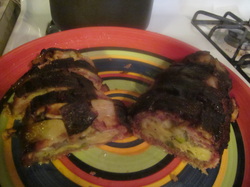 So this has almost nothing to do with homebrewing other than the fact that I had a few of the Rye-childs to wash it down but I thought it was awesome enough to write about and got some great pictures out of it. So here it is; the fatty. The bacon explosion. The heart stopper. Call it what you will but basically it is some filling (can literally be anything although I chose mac-n-cheese) rolled up in a pound of sausage and then wrapped in a blanket of bacon and slow cooked with smoked woods for a few hours. If you need a more detailed explanation of it I've included a link to where I discovered this awesomeness below. http://www.bbqaddicts.com/blog/recipes/bacon-explosion/ Long story short this was probably the best thing that I have ever tasted in my entire life. Smoked bacon and sausage is amazing and greasy mac-n-cheese with it was terrific. Everyone loved it although the sheer awesomeness of this beast of a meal (or side dish?) severely limited how much one person could actually eat in one sitting. Honestly don't know what else to say because words can only go so far.
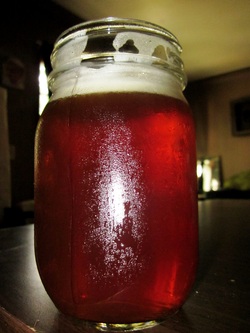 Time for some tasting notes from my second incarnation of the Redheaded Rye-child. Here is a link to the recipe in case you missed it but basically this is an American Amber Ale with a quarter Rye Malt and some dry hops. http://inhousebrew.weebly.com/red-headed-rye-child.html Aroma: Picking up a bit of the spicy, herbal notes that can come from Sterling hops but not really getting much of the Cascade right now. The malty sweetness is coming through as well. Appearance: Looks pretty damn good for a red ale I think. Clarity came through after a week on tap in the freezer. Great head retention with all that Crystal. Color is pretty good and I'll admit I borrowed the idea of the C-120 in combination with Special B from an online forum. With most beers I wouldn't fret about color but when making a Red Ale I feel like it should be RED. Next time I think I'll try a full half pound of C-120 and Special B each to see if I can get a deeper red color. Flavor: I think I've achieved a nice balance on this beer between the caramel sweetness of the C-120 and Special B and the dryer spiciness of the Rye Malt. While it starts off sweet it finishes mostly with the Rye flavor and the Sterling hops lingering. Still not much to be heard from the Cascade. Not bad, but next time I think I will drop the Sterling hops and stick strictly to a citrus based hop combination. Mouthfeel: This beer has a nice full body resulting from the higher percentage of crystal malts and the high mashing temperature. Finishes well and goes down pretty easy. Overall Impressions: Pretty much what an American Amber Ale with 27% Rye Malt and some dry hops should taste like. More full bodied than an APA but more heavily hopped than a traditional American Amber. It's getting there. Next Time: This beer falls into the weird specialty category working off a American Amber Base per the BJCP and the questions for next time mostly revolve around whether or not I should keep it there or up the hops and gravity and just turn it into more of a Red Rye IPA. I feel like I have a decent start on this beer after two trys and think a Red Rye IPA could be a completely different beer (that I will need to make) but I'll stick with what I have going on this one. I know I like the combo of the C-120 and Special B and will try upping those as previously stated to achieve a more reddish tone. The rye is good, but I might even up it a little bit further. The hops I like but think that a more citrus based hop combination with more backloaded toward the end of the boil will improve the recipe. As for everything else I think it stays as is so until next time, bottoms up!
|








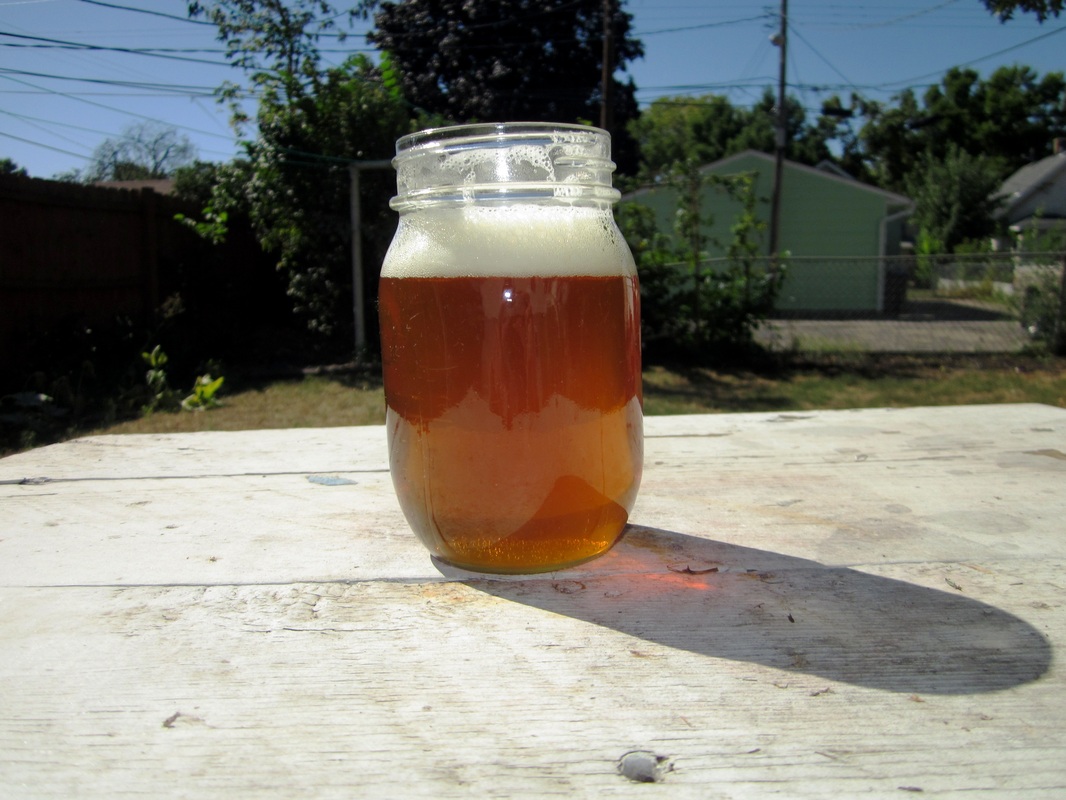
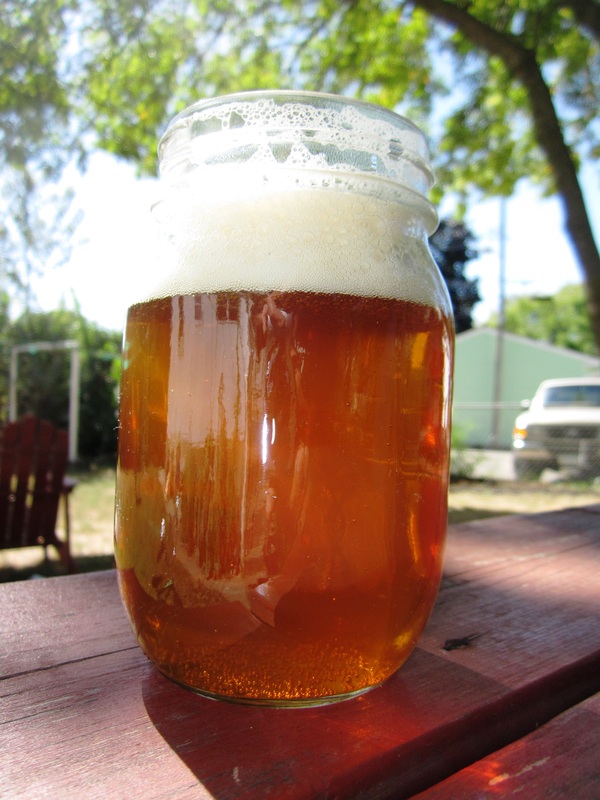

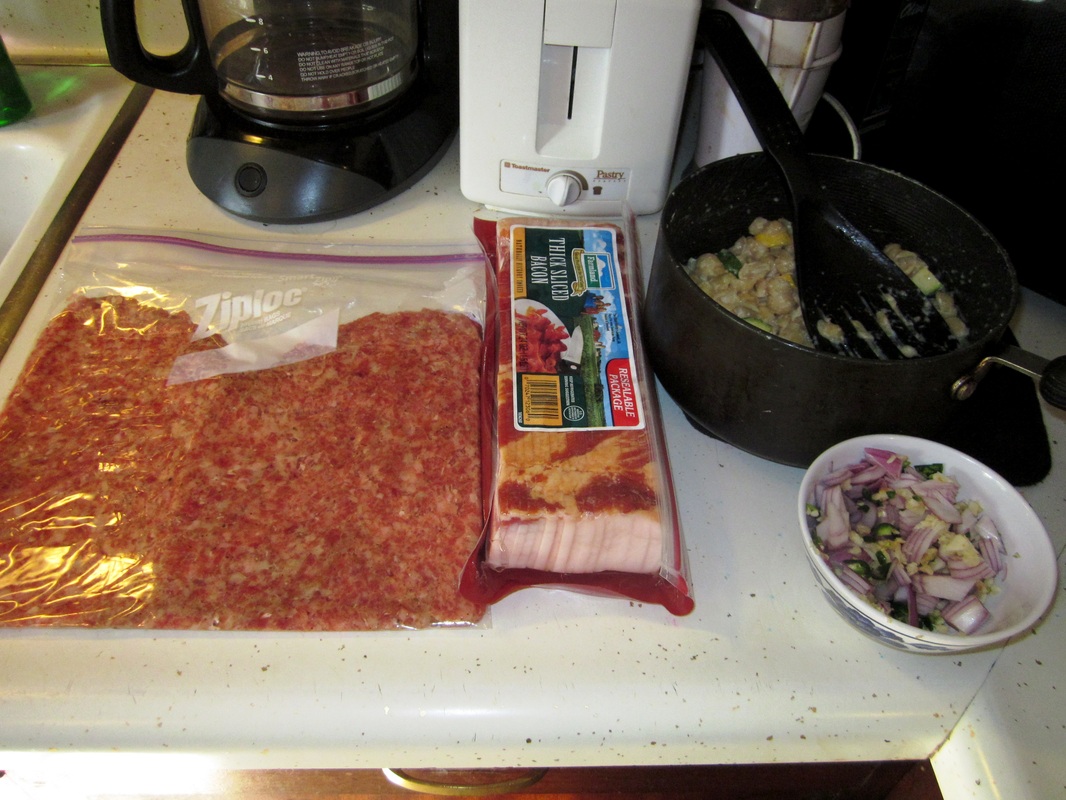
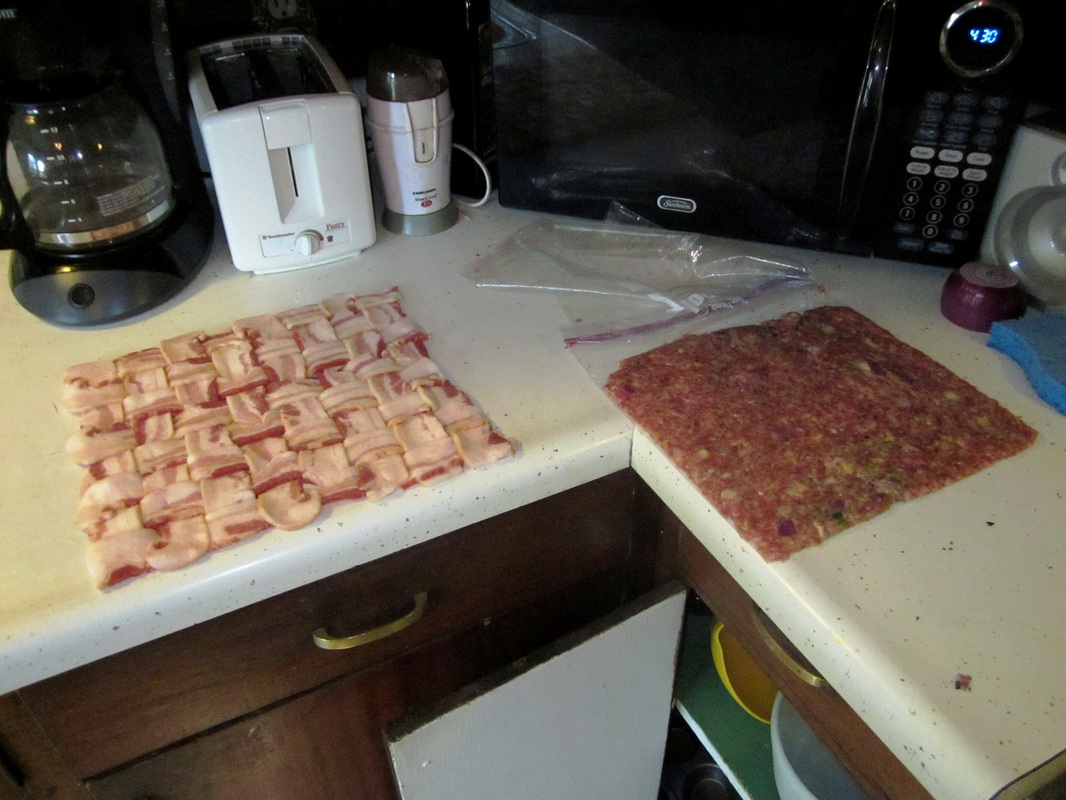
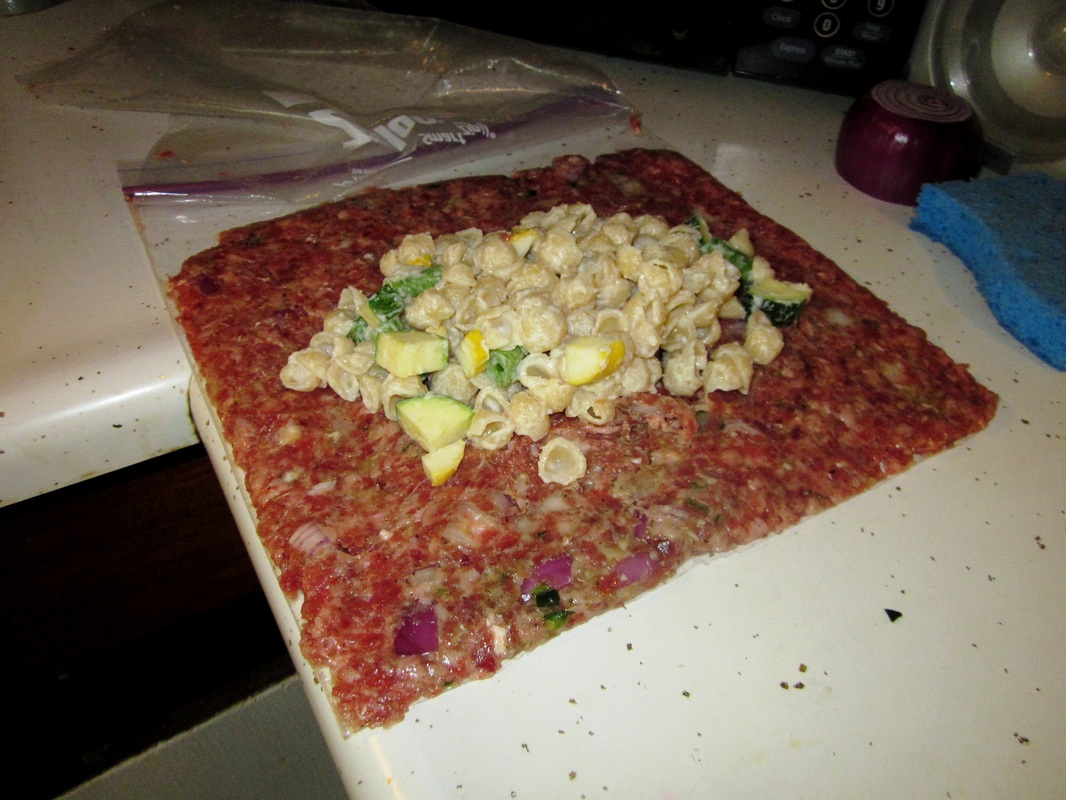
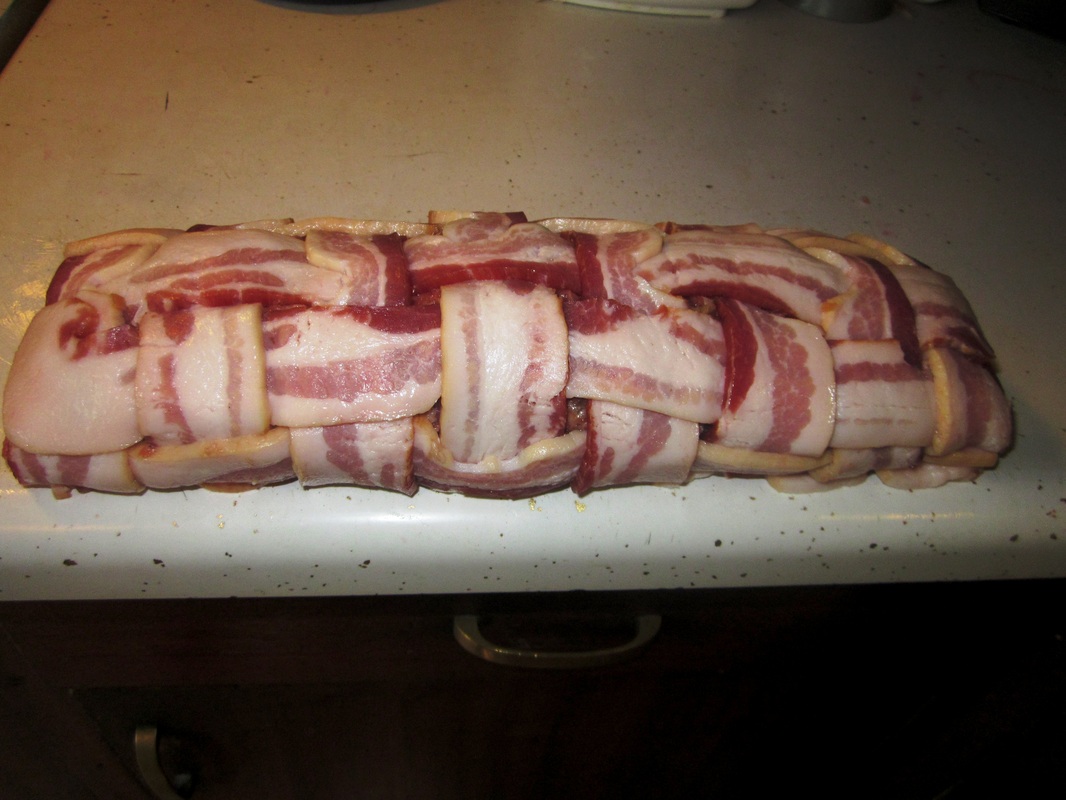

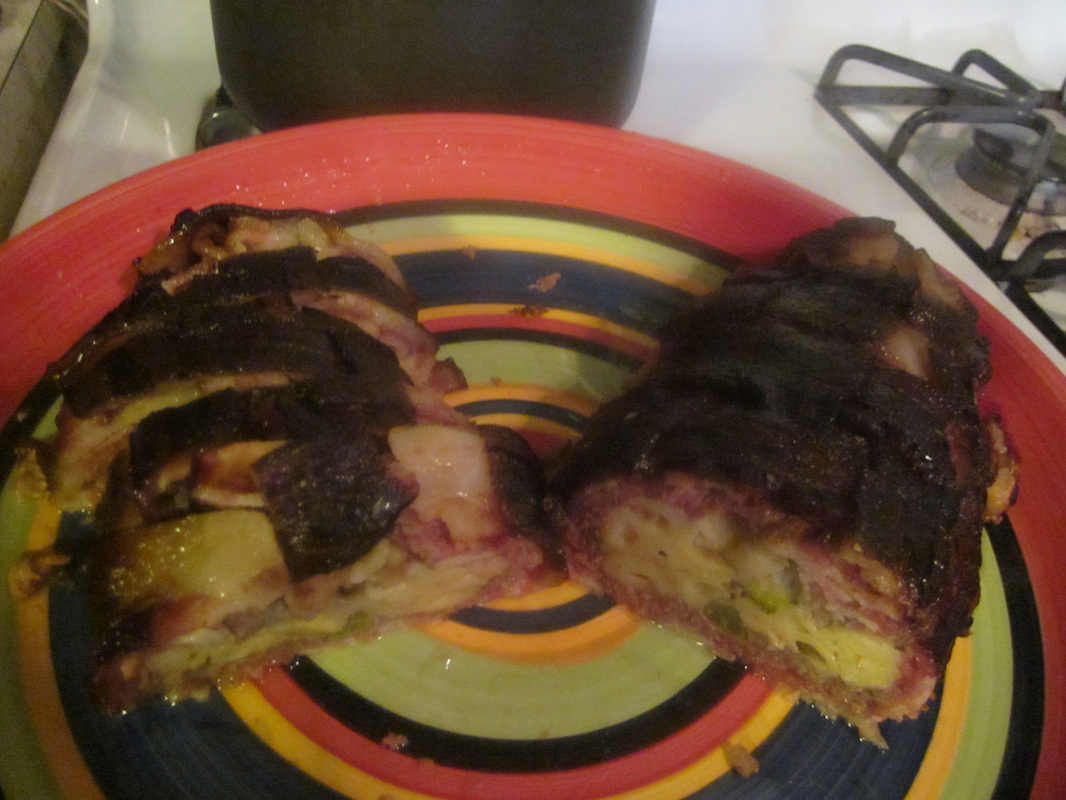

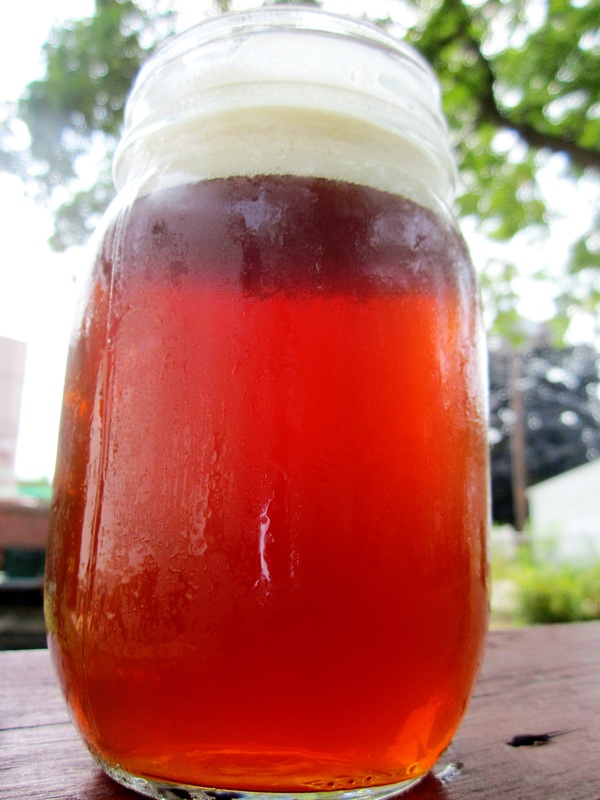

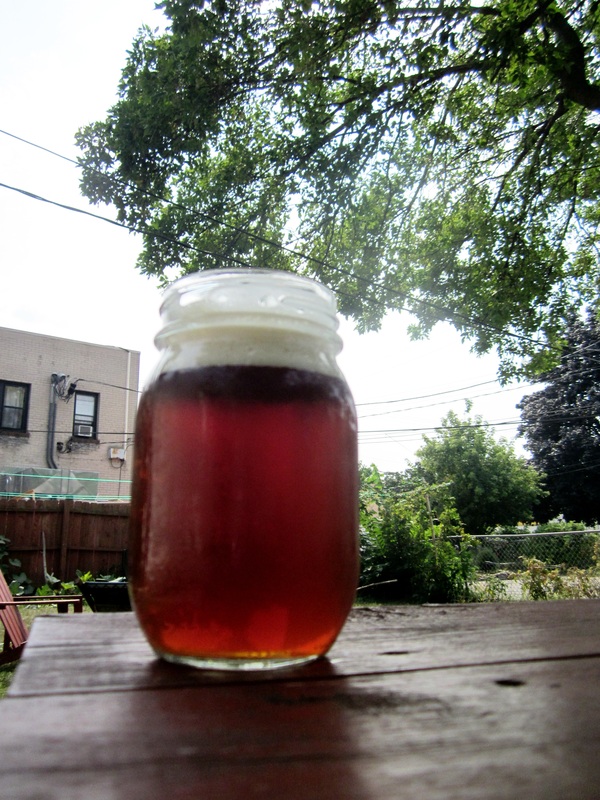
 RSS Feed
RSS Feed